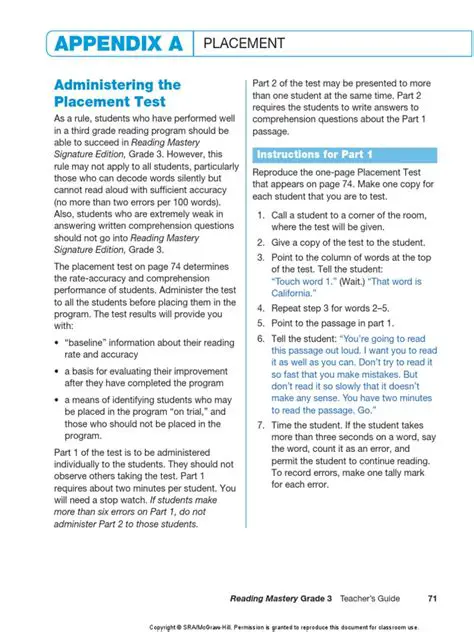Importance of Reading Mastery
Reading mastery is a crucial skill that underpins academic success and lifelong learning. According to the National Assessment of Educational Progress (NAEP), only 35% of 8th graders are proficient in reading, highlighting the need for effective assessment and placement strategies to ensure that students receive the appropriate support they need to achieve reading mastery.

Purpose of the Reading Mastery Placement Test
The Reading Mastery Placement Test is designed to assess students’ reading skills and determine their appropriate instructional level. This information is critical for educators in placing students in classrooms and providing individualized instruction that meets their specific needs.
Key Components of the Reading Mastery Placement Test
The Reading Mastery Placement Test typically includes the following components:
- Phonemic Awareness: Measuring the ability to identify and manipulate individual sounds in words.
- Phonics: Assessing the ability to decode and encode words based on their sound-letter relationships.
- Fluency: Evaluating the speed, accuracy, and automaticity of reading.
- Comprehension: Determining the understanding of written text, including main ideas, supporting details, inferences, and critical thinking.
Common Mistakes to Avoid
When taking the Reading Mastery Placement Test, it is important to avoid common mistakes that can lead to inaccurate results:
- Guessing: Avoid making educated guesses, as this can lower your overall score.
- Rushing: Take your time and read the instructions carefully to understand the task.
- Ignoring Context: Pay attention to the surrounding text to provide context when decoding unfamiliar words.
- Overthinking: Stick to the information provided and avoid making unnecessary inferences or interpretations.
Why the Reading Mastery Placement Test Matters
The Reading Mastery Placement Test provides valuable information that enables educators to:
- Identify Struggling Students: Early identification of students with reading difficulties allows for timely intervention and support.
- Provide Individualized Instruction: The test helps determine the appropriate instructional level and materials for each student, ensuring a targeted approach to learning.
- Monitor Progress: By administering the test regularly, educators can track students’ progress over time and adjust instruction accordingly.
Benefits of Reading Mastery
Achieving reading mastery offers numerous benefits for students, including:
- Improved Academic Performance: Reading skills are essential for success in all academic subjects.
- Enhanced Cognitive Abilities: Reading stimulates critical thinking, problem-solving, and imagination.
- Broadened Knowledge and Skills: Reading exposes students to a wide range of ideas, perspectives, and perspectives.
- Increased Confidence: Reading empowers students with the ability to access and comprehend information independently.
How the Reading Mastery Placement Test Can Help
The Reading Mastery Placement Test serves as a valuable tool for educators to:
- Assess Reading Abilities: Measure students’ reading skills comprehensively and identify areas of strength and weakness.
- Determine Instructional Level: Place students in the appropriate instructional group or classroom based on their test results.
- Provide Data-Driven Instruction: Use test results to inform individualized lesson plans and instruction that meet students’ specific needs.
New Applications for the Reading Mastery Placement Test
Leveraging the power of artificial intelligence (AI) and machine learning, the Reading Mastery Placement Test can be adapted for innovative applications:
- Adaptive Assessments: AI-driven assessments can adjust the difficulty of questions based on student responses, providing a more accurate and personalized assessment.
- Intervention Recommendations: Machine learning algorithms can analyze test results and suggest tailored intervention strategies for struggling students.
- Longitudinal Tracking: AI can track student progress over time, identifying students who may need additional support or acceleration.
Conclusion
The Reading Mastery Placement Test is an essential tool for educators to assess students’ reading abilities and provide appropriate instructional support. By avoiding common mistakes, understanding its importance, and embracing its benefits, educators can use the information provided by the test to empower students with the skills they need to achieve reading mastery.
Tables Summary
Table 1: Components of the Reading Mastery Placement Test
| Component | Description |
|---|---|
| Phonemic Awareness | Identifying and manipulating individual sounds in words |
| Phonics | Decoding and encoding words based on sound-letter relationships |
| Fluency | Speed, accuracy, and automaticity of reading |
| Comprehension | Understanding of written text, including main ideas, supporting details, inferences, and critical thinking |
Table 2: Common Mistakes to Avoid
| Mistake | Reason |
|---|---|
| Guessing | May lower overall score |
| Rushing | May lead to inaccurate answers |
| Ignoring Context | May hinder word decoding |
| Overthinking | May create unnecessary confusion |
Table 3: Benefits of Reading Mastery
| Benefit | Description |
|---|---|
| Improved Academic Performance | Success in all academic subjects |
| Enhanced Cognitive Abilities | Stimulates critical thinking, problem-solving, and imagination |
| Broadened Knowledge and Skills | Exposure to a wide range of ideas and perspectives |
| Increased Confidence | Empowers students to access and comprehend information independently |
Table 4: New Applications for the Reading Mastery Placement Test
| Application | Description |
|---|---|
| Adaptive Assessments | Adjusts difficulty based on student responses |
| Intervention Recommendations | Suggests tailored intervention strategies |
| Longitudinal Tracking | Tracks student progress over time |
